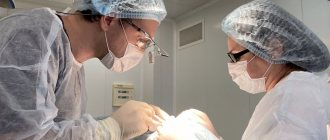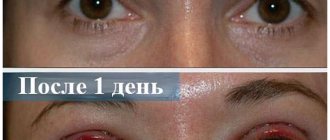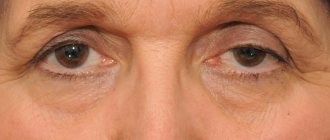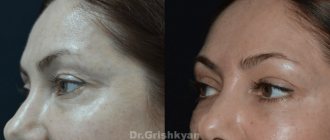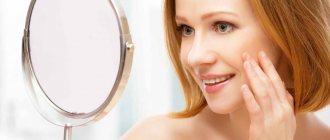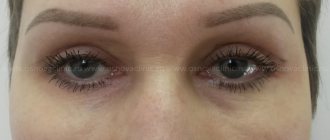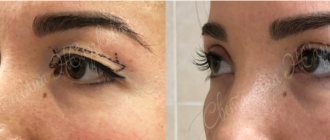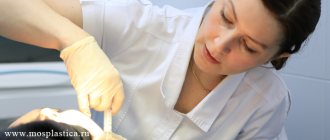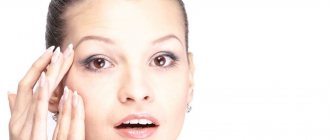Blepharoplasty is an operation aimed at eliminating age-related changes in the upper and lower eyelids or their congenital anomalies. With blepharoplasty, you can remove the overhang of the upper eyelid, swelling and bags under the eyes, correct asymmetry, make the eyes larger and change their shape. As a result, the look becomes more open, lighter, and the face is visually rejuvenated. Blepharoplasty is a fairly common procedure, it is low-traumatic and has a minimal risk of complications.
Rehabilitation after blepharoplasty
The operation is most often performed under local anesthesia. Additionally, the patient may undergo intravenous sedation; he will be in a sleepy state without feeling anxiety or fear. The procedure lasts 1-2 hours. After the patient comes to his senses, he is under the supervision of a doctor for some time. Depending on the clinic’s policy, the scope of the intervention, and the course of the postoperative period, you can go home a few hours after the procedure or spend the first day in the hospital.
Feelings after surgery
After blepharoplasty, the patient may experience the following symptoms:
- swelling, feeling of heaviness of the eyelids;
- pain in the intervention area;
- hematomas (usually under the lower eyelids);
- dry eyes or, on the contrary, lacrimation;
- diplopia (double vision), blurred vision.
Not all the symptoms from the list will necessarily be present; the appearance of some of them depends on the type of blepharoplasty, the patient’s skin type (swelling is more pronounced on oily skin than on dry skin), lifestyle, diet, compliance with all preoperative doctor’s recommendations and other factors. All these phenomena are reversible and disappear without a trace within a few days or by the end of the recovery period.
What else does the period depend on?
Recovery time also varies depending on the complexity and volume of operations and, of course, the technique. Rehabilitation after transconjunctival blepharoplasty will take less time than rehabilitation after circular blepharoplasty, because circular correction is more traumatic for tissues.
To speed up the resolution of bruises and swelling, you can apply cold compresses and use ointments that stimulate the reduction of bruising and swelling. It is also advisable to sleep in a semi-sitting position to prevent blood flow to the head. To do this you will need several pillows.
Rehabilitation period by day
1 day. The patient is discharged from the clinic after the operation. On this day, the eyes are most sensitive to light, so it is recommended to have dark glasses with you to put on before going outside. By evening, swelling increases. Possible lacrimation, dry eyes, blurred vision.
To reduce pain, your doctor may prescribe analgesics. Any medications (drops, ointments) should be used only as prescribed by a doctor. It is necessary to remain calm and avoid any strain on the eyes. You need to sleep on your back, with your head elevated, to improve the flow of fluid from the upper body and reduce swelling.
2-3 days. Painful sensations decrease, swelling, on the contrary, increases, reaching a maximum on the 3rd day. It is acceptable to use a cold compress on the eyes - apply an ice pack wrapped in several layers of clean, dry cloth to the operated area. There may be numbness and impaired sensitivity of the skin in the surgical area.
These days you can already wash your face and hair, trying not to wet the skin of your eyelids. As before, you should try not to strain your eyesight, devote a minimum of time to reading, watching TV, and working at the computer. The patient must continue to follow all the doctor’s prescriptions - drops, treatment of sutures if necessary.
3-5 days. Symptoms persist or improve slightly.
5-7 day . Usually on the 5th day a follow-up examination is scheduled in the clinic, the surgeon removes the sutures (if self-absorbable threads were not used). There may be redness and slight swelling in the area of the sutures.
7-10 days. Symptoms gradually decrease, and by day 10 the patient can return to normal life with some restrictions on eye strain. After 10-14 days you can wear contact lenses.
The final result of the operation can be assessed after 1-2 months. By this time, the epidermis of the skin of the eyelids is renewed, the seams become unnoticeable. After six months, postoperative scars are almost impossible to detect; they look like a thin strip in the crease of the upper eyelid or along the lower edge of the eyelashes.
Recovery after blepharoplasty: what awaits the patient during the rehabilitation period
In recent years, both women and men have undergone upper and/or lower eyelid lifts. This manipulation is not considered too difficult, although it can cause quite serious complications if performed by an insufficiently experienced surgeon.
As with any other invasive procedure, recovery after blepharoplasty is necessary. How many days the recovery will last depends on 2 factors - the type of surgery performed and the individual characteristics of the person: age, health status, presence of bad habits. On average, this difficult period takes from 2 weeks to 1-2 months. TecRussia.ru talks about exactly what patients should prepare for in advance.
↑ Feelings after eyelid surgery
Contrary to advertising promises, the operation cannot be called easy and painless. The first few days a person feels uncomfortable. During rehabilitation days, he may experience:
- Nausea. The attacks occur as a result of withdrawal from anesthesia and should stop after a maximum of 6-8 hours. New generation drugs practically eliminate such unpleasant sensations, but are quite expensive.
- Soreness. Present for 2-3 days, relieved with analgesics.
- Increased tear production. It may last for three days after blepharoplasty; this is considered a normal and expected side effect. If your eyes continue to water for a longer period of time, you should consult a doctor.
- Excessive sensitivity to light. Sometimes it goes away in one or two days, but often lasts much longer, so a person who has had blepharoplasty of the lower or upper eyelid has to wear sunglasses for the entire rehabilitation period.
- Sensory disturbances, the most common being numbness in the area of the incisions on the eyelids. Occurs due to damage to the nerve roots. It takes up to several months for the correct innervation of the area around the eyes to be fully restored.
In the early postoperative period, the body needs rest. How to ensure it? In advance, before eyelid surgery, you should ask someone close to you to stay nearby over the next few days to provide all possible assistance - prepare dinner, provide comfort at home, and, of course, provide moral support.
↑ Features of rehabilitation after blepharoplasty, timing
Full recovery can last from 14 days to 2 months, sometimes a little longer. During this period, the operated eyelids gradually return to normal (sutures fuse, hematomas and swelling resolve). An approximate recovery scheme looks like this:
↑ First day
In most cases, blepharoplasty does not require a long hospital stay. If there are no complications, the patient goes home a few hours after the operation (be sure to wear protective glasses to prevent infection from getting into the fresh stitches).
- Due to the special lubricant that is applied to the eyes to keep them from drying out during surgery, your vision will be blurry for several hours.
- Of course, there can be no talk of any physical activity. The most correct thing would be to take a lying position and rest - be sure to use several pillows so that your head is well above your body. No reading, watching TV or working at the computer - any strain on the eyes is strictly prohibited!
- The eyelids will feel heavy and swollen. To minimize swelling, cold compresses are used - the surgeon will tell you the rules and frequency of their application. He will also prescribe drops or ointment to prevent dry eyes, as well as painkillers to relieve discomfort and a course of antibiotics to prevent infections.
↑ First week
After 3-4 days, postoperative swelling and bruising begin to gradually resolve. The edges of the incisions grow together, fresh scars look bright pink, there may be numbness or, conversely, increased sensitivity of the eyelids. Sometimes you still see double, your vision remains blurry, but normally all these “side effects” should go away by the middle of the first week.
- The general recommendations are the same as for the earliest period: plenty of rest, sleep with your head held high, protect your eyes and skin from ultraviolet radiation and other external influences, take all prescribed medications. Those who use contact lenses should stop wearing them for a few more days (you can wear glasses). Working at a computer, watching TV and reading are allowed from the third day.
- Smoking, alcohol, and drugs that affect blood clotting remain prohibited. Tangible physical activity should also be excluded, but you shouldn’t linger: walking around the house, doing small things (without bending over or lifting weights!) will be useful.
- As for hygiene: you can carefully wash your face and hair, the main thing is not to bend your neck down so that there is no blood flow to the eyelids, and not to allow large volumes of water to get into the operated areas.
- By the end of the first week, the stitches begin to itch very much - these sensations always accompany the healing of the edges of the wound, and are also associated with the fact that the skin has been covered with a plaster for a long time. It is extremely important to restrain yourself and under no circumstances rub or try to scratch your eyelids. After the stitches are removed, the discomfort usually goes away.
↑ 2-4 weeks
The eyes are looking better and better, the traces of the operation are almost invisible from the outside. The reflection in the mirror begins to please you and you can evaluate the preliminary result. Some patients go back to work after 7-10 days, but it would be more correct and safer to wait at least 2 weeks. By the end of this period, swelling and bruising should completely go away, many restrictions are lifted (you can return contact lenses, do makeup, etc.)
↑ A month and later
From this moment on, the longest prohibitions begin to be lifted - on sports, baths and other thermal procedures, visiting the pool, eyelash extensions, etc. However, before returning to your normal routine, you should check with your surgeon as recovery time varies from person to person. As a rule, scars at this time are already barely noticeable, but their formation is not yet complete - protection from the sun is necessary, as well as the use of healing ointments.
The rehabilitation period is affected by:
- Patient's age. The older you get, the slower the skin heals. In addition, the vessels of older people are more fragile and brittle, so hematomas are usually larger and take longer to resolve.
- Skin type. On dry cuts, the cuts are healed a little slower than on oily ones. On a thick one - longer than on a thin one.
- Compliance with the rules of the postoperative period
↑ Duration of healing of scars and timing of suture removal
Incisions when correcting the upper and/or lower eyelids are inevitable; this is the only way to excise excess skin and remove fat deposits. Their length, shape and location depend on the surgical technique. Upon completion of the work, the surgeon applies cosmetic stitches, then the edges of the wound need time to heal. After 4-7 days they grow together quite firmly, the sutures are removed, but the process of tissue regeneration itself continues for several more months!
- See also the article
“How do stitches heal after blepharoplasty and how to make them invisible?”
During this time, the scar goes through 4 stages of formation. Visually, it first turns red and plump, then turns pale. Since the skin in the eyelid area is very thin, usually after 10-12 weeks, blepharoplasty scars become barely noticeable. If, after this time, the person who has had their eyelids lifted is not satisfied with the appearance of the scars, it is necessary to contact a plastic surgeon for additional consultation.
↑ How long does it take to restore the aesthetics of the upper and lower eyelids
The period during which the body returns to normal is individual, and on average is about 1-2 months. But patients are most often concerned only with external changes - i.e. when exactly will it be possible to go out or visit without fear of scaring people with your appearance and when can you go to work without provoking awkward questions about the operation. The deadlines here are:
- On average, swelling, bruising and redness from the upper eyelids disappear within 5-10 days.
- For the lower ones, the rehabilitation period is a little longer - about 2 weeks. The same applies to circumferential blepharoplasty.
- After an operation performed transconjunctivally (through an incision along the inner edge of the mucosa), tissue structures are restored even faster - within 1 week. In this case, there is no scar on the eyelid; no stitches are required.
- It is believed that laser blepharoplasty is less traumatic and skin rehabilitation occurs faster. This is not so; there are no fundamental differences in timing in this case. However, if the surgeon worked carefully, there will be fewer bruises, which is due to the laser's ability to seal blood vessels.
- After the Sangapuri operation, during which the eyelids are not only tightened, fat deposits are removed, but also the shape of the eyes is corrected, the recovery period is the longest and can be up to 1-2 months.
↑ Prohibitions by day
After plastic surgery of the upper and/or lower eyelids, it is necessary to adhere to a number of restrictions that are aimed at speeding up and facilitating rehabilitation:
- giving up bad habits (alcohol, smoking) for 2 weeks
- For the first 2-3 days, it is necessary to minimize eye strain - avoid sitting at the computer, watching TV, or reading.
- Heavy physical work, especially with bending, as well as any active sports and leisure activities, incl. Swimming and dancing are not allowed for 3-4 weeks.
- visiting the sauna and bathhouse, taking a hot shower or bath are prohibited in the next month after blepharoplasty;
- washing your hair is allowed only on the 4th day, and water should not get on your eyelids (small drops are not a big deal);
- For the first 7-10 days, the use of decorative cosmetics is unacceptable;
- Do not rub the skin around the eyes with your hands for 10-14 days;
- Avoid contact lenses for at least 1 week;
- Do not take blood thinning medications for two weeks.
Recommendations on restrictions are given by the doctor who performed the operation. If they are followed, recovery after blepharoplasty is quick and without complications.
↑ Exercises and massage
Gymnastics for the eyes stabilizes blood circulation in the area of the lower and upper eyelids that have undergone surgical manipulation. It includes the following exercises:
- Look forward, then look away to the right, left, down, up.
- Blink for 2-3 seconds so that the eye muscles relax, then alternately close your eyes tightly, loosen your eyelids, and cover them with warm palms.
- Place your fingers on your eyelids, perpendicular to your nose, without pressure, and open your eyes, despite the resistance.
Lymphatic drainage massage sessions help speed up recovery, promoting the outflow of lymph from damaged tissues. Due to this, swelling and hematomas resolve faster. You can start the course after about 1 week, in agreement with your surgeon.
- At what age should blepharoplasty be done: surgeon’s recommendations
- Repeated blepharoplasty: how, when and why it is performed
↑ What are the complications?
When an eyelid lift is performed by a competent specialist, and the patient does not violate the rules of rehabilitation, negative consequences occur extremely rarely, and even if this happens, they manifest themselves in a mild form and go away on their own after a short time. These include:
- volumetric edema and hematomas, incl. retrobulbar (in the depths of the orbit);
- inflammatory processes;
- sutures coming apart, forming rough scars;
- conjunctivitis, diplopia and other functional eye problems;
- Read more about possible complications after blepharoplasty in the article by Ph.D. Ekaterina Kudinova.
To avoid such troubles, you need to strictly follow all the rules of rehabilitation, not skip scheduled examinations and carefully monitor the condition of your body. The main signs that “something went wrong”:
- heaviness in the chest, breathing problems, heart rhythm disturbances;
- increasing pain in the eyelid area, local or general increase in temperature;
- any visual impairment.
In these cases, it is necessary to contact your surgeon as quickly as possible, and if he is not available, to any other doctor in order to conduct an in-person examination, find out the reasons and prescribe the necessary treatment.
Nuances of recovery for various types of blepharoplasty
After upper eyelid blepharoplasty, the recovery period is the fastest. Hematomas occur very rarely. Pain and swelling go away faster than with circumferential blepharoplasty and lower eyelid surgery.
Circumferential blepharoplasty and lower eyelid surgery require a slightly longer rehabilitation period, usually lasting up to 2-3 weeks. Swelling and pain are more pronounced, and bruises under the eyes may be present.
Transconjunctival blepharoplasty is performed through an incision on the inside of the eyelid. It is used only for the correction of lower eyelid defects. The least painful method with a quick recovery period, after which there are no scars.
How long does the result of blepharoplasty last?
Age-related changes in the eyelids begin to worry women closer to 25-30 years old. They are associated with loss of skin elasticity, the presence of a large amount of subcutaneous fat, excess skin on the eyelids, etc.
Blepharoplasty helps to neutralize the external manifestations of a number of age-related changes and defects. With its help you can fight with:
- Drooping of the upper eyelid (ptosis);
- Unattractive or vision-impairing eye shape;
- Fatty hernias, excess fatty tissue in the eyelids;
- Asymmetry of the incision;
- Loose eyelid skin, facial and deep wrinkles;
- Chronic “bags”.
How many years do the results of blepharoplasty last? Surgery cannot completely stop the aging process. She can only visually remove its consequences for a certain period.
How long the results of blepharoplasty last depends on you and the surgeon. If the operation was successful, and during the rehabilitation period you followed the doctor’s recommendations, the results will be noticeable from 7 years to 15 years.
Eyelid skin care after blepharoplasty
In the first days after surgery, an antiseptic patch is applied to the stitches. After 2-3 days it is removed. Sutures should be treated with any solutions only on the recommendation of the surgeon; this is not always required. As a rule, sutures are removed 5-7 days after surgery.
No special eyelid skin care is required after blepharoplasty. You need to follow normal hygiene rules, try not to cry or rub your eyes. You can use your usual cosmetics after the stitches are removed and the scars are completely healed. To quickly resolve scars, the doctor may recommend a special gel, but it is not recommended to use it without a prescription.
When can I see the final result of blepharoplasty?
The first few days the effect will not be noticeable. On the contrary, during the first three days, swelling, bruising and sometimes hematomas will appear on the eyelids. This is fine. Starting from the fourth day, swelling will subside.
The final result after blepharoplasty is visible after 2 weeks. On days 10-14, the patient's eyelids look aesthetically attractive. Only barely noticeable scars may remain until the 40th day after surgery.
There is no point in worrying about scars - the incisions are made in places of natural folds and “repeat” them.
Recommendations to speed up rehabilitation
To quickly recover after blepharoplasty and achieve optimal surgical results, additional procedures are indicated:
- Massage of the skin around the eyes and eye gymnastics. They help improve blood circulation in the intervention area and strengthen the orbicularis oculi muscle. The surgeon who performed the operation will tell you when you can start these procedures, advise the correct massage technique, and show you exercises for the eyes.
- Physiotherapy. Microcurrent therapy is most often used, which normalizes lymph flow, eliminates swelling, and accelerates skin healing. Also shown are UHF and phonophoresis.
- Maintaining sufficient skin hydration. Cosmetic products should be used after scars have healed.
REPEATED BLEPHAROPLASTY
However, there is no need to panic in any of these cases. If you have undergone blepharoplasty and it was unsuccessful, in any modern clinic you will be offered a repeat operation. Repeated intervention will help correct inaccuracies made during the initial procedure and provide the result that you originally expected.
The only difficulty is to find a specialist whom you really trust. Because after an unsuccessful operation, patients are usually afraid of repeated failure. Collect information about different clinics, look at reviews of the work of the most famous surgeons, talk with friends who have undergone plastic surgery and are satisfied with the result.
On the website in the appropriate section you can find real patient stories with attached photographs before and after the procedure. And, of course, the surgeon himself will help to fully clarify the situation during an individual consultation.
Restrictions after surgery
Most prohibitions are temporary and must be adhered to until the end of the rehabilitation period (from 1-2 weeks to 1-2 months).
After blepharoplasty you cannot:
- expose your eyes to bright light and sunlight;
- allow excessive visual strain;
- experience physical activity, including active sports;
- lift weights;
- visit the bathhouse, sauna, solarium;
- rub your eyes;
- wear contact lenses;
- sleep face down or without a pillow;
- apply decorative cosmetics;
- try to remove stitches and healing crusts yourself;
- eat spicy, salty foods, smoked foods;
- smoking and drinking alcohol.
Subsequently, it is necessary to constantly apply a cream with a high sun protection factor to the skin around the eyes. Minimally invasive cosmetic procedures (Botox, mesotherapy) are allowed 2-3 months after surgery.
Possible complications
Blepharoplasty is known as an intervention with a minimal percentage of complications. However, some unpleasant consequences are still possible. Among them:
- hemorrhage in the sclera of the eye;
- hyperreaction to light;
- severe and prolonged lacrimation;
- inflammatory processes in the suture area;
- inflammation of the conjunctiva
- eversion of the century.
Sometimes these phenomena go away on their own; in some cases, medication is required. If, a few days after the operation, cutting pain, redness of the conjunctiva, an increase in previously minor symptoms, hyperemia or suppuration of the sutures, or an increase in body temperature appear, you should urgently contact the clinic where the intervention was performed.
Choosing a clinic and doctor with a good reputation, positive reviews, as well as following all the doctor’s recommendations in the pre- and postoperative period will help minimize the risk of complications.
Sun and exercise
In the first few days after surgery, you should completely avoid any physical activity and exposure to direct UV rays on the skin of the eyelids.
Note! Some physical exercises can cause an increase in intraocular pressure. This is extremely undesirable during rehabilitation after blepharoplasty.
Avoid doing push-ups and pull-ups. Limit yourself to brisk walking. You can resume training 10-14 days after surgery (depending on the speed of recovery after blepharoplasty).
Perform therapeutic exercises twice a day: morning and evening. Here is an approximate set of exercises:
- Look straight ahead. Move your gaze clockwise: first up, then right, down and left. Repeat the exercise 5-7 times;
- Blink for 30 seconds with your head tilted back;
- Close your eyes and open them wide, trying to focus on a distant object. Repeat 5-7 times;
- Close your eyes and stretch the skin at your temples to the sides. Repeat the exercise 5-7 times.
